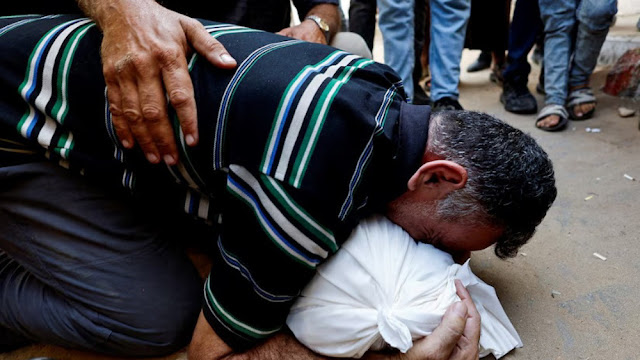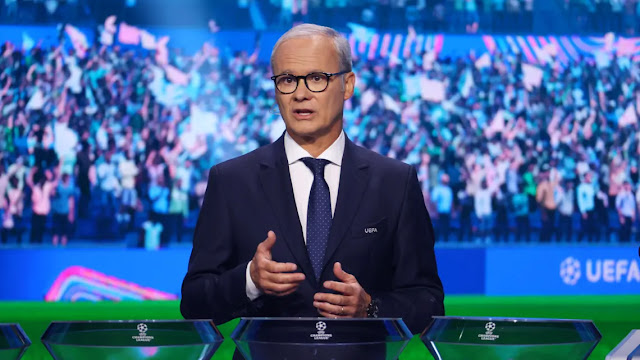In a devastating escalation of violence, Israeli military operations across multiple areas of the Gaza Strip have resulted in the deaths of at least 16 Palestinians, with dozens more wounded, as intensified bombardments targeted the southern region of the besieged territory on Thursday, August 28, 2025. The strikes, which have pounded densely populated neighborhoods, have deepened the humanitarian crisis in Gaza, where families are grappling with displacement, loss, and a severe lack of basic necessities. The Gaza health ministry reported that the latest fatalities have pushed the death toll from Israeli attacks in the past 24 hours to 71, underscoring the relentless pace of the violence.
Palestinian father Mahmoud Abedrabo mourns over the body of his son Hamada, who was killed in an Israeli strike, according to medics, at al-Shifa Hospital in Gaza City, on August 24, 2025. (Photo by Reuters)
Residents of Gaza City, the largest urban center in the territory, described a sharp escalation in military bombardment, particularly around the city’s outskirts. Eastern neighborhoods such as Shuja’iyya, Zeitoun, and Sabra bore the brunt of the attacks, forcing families to flee their homes, primarily toward the coast in search of safety. In southern Gaza, Nasser Hospital in Khan Younis has become a critical lifeline, receiving numerous Palestinians suffering from gunshot wounds. A physician at the facility reported that Israeli forces opened fire on a gathering of civilians near a designated aid distribution site, highlighting the dire risks faced by those seeking basic necessities like food.
The Israeli military’s stated objective is to target what it describes as Hamas cells and infrastructure, characterizing Gaza City as the group’s final stronghold. However, the intensification of attacks has drawn global condemnation, with international appeals urging Israel to reconsider its planned advance on Gaza City due to fears of catastrophic civilian casualties and the displacement of approximately one million Palestinians currently seeking refuge there. Since October 7, 2023, the Gaza health ministry reports that at least 62,966 Palestinians, predominantly women and children, have been killed, and 159,266 others injured in Israel’s ongoing offensive. The conflict has also drawn significant international legal scrutiny, with the International Criminal Court (ICC) issuing arrest warrants in November 2024 for Israeli Prime Minister Benjamin Netanyahu and former Minister of Military Affairs Yoav Gallant for war crimes and crimes against humanity. Additionally, Israel faces a genocide case at the International Court of Justice (ICJ) for its actions in Gaza.
This article provides a detailed examination of the recent escalation, the humanitarian toll, the historical and geopolitical context of the Israel-Palestine conflict, and the broader implications for the region and the international community.
The Recent Escalation: A Snapshot of Violence
The latest wave of Israeli military operations in Gaza has intensified an already dire situation, with Thursday’s attacks claiming at least 16 lives across multiple areas. The Gaza health ministry’s report of 71 deaths in the past 24 hours reflects the unrelenting pace of the violence, which has targeted both urban and densely populated residential areas. In Gaza City, residents described a terrifying barrage of airstrikes and artillery fire, particularly in the eastern neighborhoods of Shuja’iyya, Zeitoun, and Sabra. These areas, home to thousands of families, have been repeatedly hit since the onset of the conflict in October 2023, leaving much of the infrastructure in ruins and forcing mass evacuations.
As families fled toward the coast, seeking relative safety from the bombardment, the scenes of displacement underscored the growing humanitarian crisis. Gaza City, once a vibrant urban hub, has been reduced to a battleground, with entire neighborhoods leveled and essential services such as electricity, water, and healthcare severely disrupted. The coastal areas, already overcrowded with displaced persons, offer little respite, as access to food, clean water, and shelter remains critically limited.
In southern Gaza, the situation is equally grim. Nasser Hospital in Khan Younis, one of the few functioning medical facilities in the region, has been overwhelmed with casualties. A physician at the hospital, quoted by Reuters, reported that many of the patients admitted on Thursday suffered gunshot wounds to the upper body, with several in critical condition. Dr. Mohammad Saqer, head of the nursing department, provided a harrowing account of the injuries, stating that the victims were shot while attempting to gather food at an aid distribution site near Rafah. This incident highlights the desperate conditions in Gaza, where civilians risk their lives to access basic necessities amidst ongoing military operations.
The Israeli military’s claim that it is targeting Hamas infrastructure has done little to assuage concerns about the disproportionate impact on civilians. The reported attack on a crowd near an aid distribution site raises serious questions about the conduct of military operations in densely populated areas and the protection of civilians under international humanitarian law. The Gaza health ministry’s figures—62,966 deaths and 159,266 injuries since October 2023—paint a stark picture of the human cost of the conflict, with women and children bearing the brunt of the violence.
Historical and Geopolitical Context
The current escalation is part of a broader conflict between Israel and Palestine that has its roots in decades of territorial disputes, political tensions, and competing national aspirations. The Gaza Strip, a 141-square-mile territory home to over two million Palestinians, has been under a blockade imposed by Israel and Egypt since 2007, following Hamas’s takeover of the territory. The blockade has restricted the movement of goods and people, leading to widespread poverty, unemployment, and a humanitarian crisis that has only worsened with successive rounds of violence.
The latest conflict began on October 7, 2023, when Hamas launched a surprise attack on southern Israel, killing approximately 1,200 people and taking over 200 hostages. Israel’s response, characterized by large-scale airstrikes and a ground invasion, has been described as one of the most intense military campaigns in the region’s history. The stated goal of dismantling Hamas’s military and governance capabilities has led to widespread destruction in Gaza, with entire neighborhoods reduced to rubble and critical infrastructure, including hospitals, schools, and water facilities, heavily damaged or destroyed.
Israel’s characterization of Gaza City as the “final bastion” of Hamas reflects its strategic focus on neutralizing the group’s presence in the territory. However, the military’s tactics, including heavy bombardment and ground operations in densely populated areas, have drawn widespread criticism for their impact on civilians. The planned advance on Gaza City, where approximately one million displaced Palestinians are currently sheltering, has raised alarms among international humanitarian organizations and world leaders, who warn of a potential catastrophe.
The conflict is further complicated by its regional and international dimensions. Israel’s military operations are supported by key allies, including the United States, which provides significant military and financial aid. However, the scale of civilian casualties and the humanitarian crisis in Gaza have strained Israel’s relations with other global actors, including the United Nations and several European countries, which have called for a ceasefire and increased humanitarian aid. The ICC’s issuance of arrest warrants for Netanyahu and Gallant in November 2024, citing war crimes and crimes against humanity, represents a significant escalation in international legal accountability, though Israel has rejected the court’s jurisdiction. Similarly, the genocide case at the ICJ, initiated by South Africa and supported by several other nations, underscores the growing global scrutiny of Israel’s actions in Gaza.
Humanitarian Crisis and Civilian Impact
The humanitarian situation in Gaza has reached catastrophic levels, with the recent escalation exacerbating an already dire crisis. The Gaza health ministry’s figures—62,966 deaths and 159,266 injuries since October 2023—highlight the staggering toll on civilians, with women and children accounting for the majority of casualties. The destruction of hospitals, clinics, and other essential infrastructure has severely limited access to healthcare, leaving facilities like Nasser Hospital overwhelmed and under-resourced.
The incident at the aid distribution site near Rafah, where civilians were reportedly shot while attempting to gather food, underscores the desperate conditions in Gaza. The blockade and ongoing military operations have restricted the flow of humanitarian aid, leaving millions dependent on sporadic deliveries of food, water, and medical supplies. The United Nations has warned that Gaza is on the brink of famine, with malnutrition rates among children soaring and access to clean water severely limited.
Displacement has become a defining feature of the crisis, with nearly the entire population of Gaza—over two million people—displaced at least once since October 2023. The movement of families from Gaza City to the coast reflects a broader pattern of forced displacement, as civilians flee areas targeted by Israeli forces only to find themselves in overcrowded and under-resourced safe zones. The planned advance on Gaza City threatens to displace an additional one million people, many of whom have already been displaced multiple times, further straining the territory’s limited resources.
The psychological toll on Gaza’s population cannot be overstated. Survivors of the violence, particularly children, are grappling with trauma, loss, and the constant threat of further attacks. The destruction of schools and educational facilities has disrupted the education of an entire generation, with long-term implications for Gaza’s social and economic recovery.
International Legal and Diplomatic Responses
The international community’s response to the conflict has been marked by a mix of condemnation, calls for restraint, and efforts to pursue accountability. The ICC’s arrest warrants for Netanyahu and Gallant, issued in November 2024, represent a historic step toward holding senior Israeli officials accountable for alleged war crimes. The warrants cite evidence of systematic attacks on civilians, including the targeting of civilian infrastructure and the use of disproportionate force. While the ICC’s actions have been welcomed by human rights organizations and some governments, Israel has dismissed the warrants as politically motivated, arguing that the court lacks jurisdiction over its actions.
The genocide case at the ICJ, initiated by South Africa in December 2023, further underscores the international legal scrutiny of Israel’s conduct. The case alleges that Israel’s actions in Gaza, including the mass killing of civilians and the destruction of infrastructure, constitute genocide under the 1948 Genocide Convention. While the ICJ has yet to deliver a final ruling, its preliminary orders have called for Israel to take measures to prevent genocidal acts and ensure humanitarian access to Gaza. Israel has rejected the allegations, maintaining that its operations are a legitimate response to Hamas’s attacks.
Diplomatic efforts to secure a ceasefire have been largely unsuccessful, with negotiations mediated by Egypt and Qatar repeatedly stalling. The United States, a key ally of Israel, has faced criticism for vetoing UN Security Council resolutions calling for an immediate ceasefire while continuing to provide military support to Israel. Meanwhile, protests and demonstrations in cities around the world have called for an end to the violence and greater humanitarian support for Gaza’s population.
Implications for the Future
The intensification of Israeli military operations in Gaza, particularly the planned advance on Gaza City, threatens to deepen the humanitarian crisis and escalate tensions in the region. The displacement of an additional one million people would overwhelm Gaza’s already strained resources, potentially leading to a humanitarian catastrophe of unprecedented scale. The targeting of civilians at aid distribution sites, as reported in Rafah, raises serious concerns about compliance with international humanitarian law and the protection of non-combatants.
For Israel, the continued military campaign risks further international isolation, particularly in light of the ICC and ICJ proceedings. The arrest warrants for Netanyahu and Gallant could complicate Israel’s diplomatic relations and limit the travel of senior officials, while the genocide case at the ICJ could have long-term implications for Israel’s global standing. Domestically, the Israeli government faces pressure from its citizens, with protests calling for the release of hostages held by Hamas and a resolution to the conflict.
For Palestinians in Gaza, the immediate priority is survival amidst ongoing violence and a collapsing humanitarian system. The long-term prospects for recovery and rebuilding are daunting, given the scale of destruction and the ongoing blockade. International aid organizations have called for unrestricted access to deliver humanitarian assistance, but the security situation and political deadlock continue to hinder these efforts.
Conclusion
The killing of at least 16 Palestinians in Gaza on August 28, 2025, and the broader escalation of Israeli military operations underscore the devastating toll of the ongoing conflict. With 62,966 deaths and 159,266 injuries since October 2023, the humanitarian crisis in Gaza has reached catastrophic levels, with civilians bearing the brunt of the violence. The reported shooting of civilians at an aid distribution site near Rafah highlights the desperate conditions faced by Gaza’s population, while the planned advance on Gaza City threatens to displace an additional one million people.
The international community’s response, including the ICC’s arrest warrants and the ICJ’s genocide case, reflects growing scrutiny of Israel’s actions, but diplomatic efforts to secure a ceasefire remain elusive. As the conflict continues, the urgent need for humanitarian aid, civilian protection, and a path toward peace has never been more critical. The events in Gaza serve as a stark reminder of the human cost of protracted conflict and the pressing need for a just and lasting resolution to the Israel-Palestine crisis.






